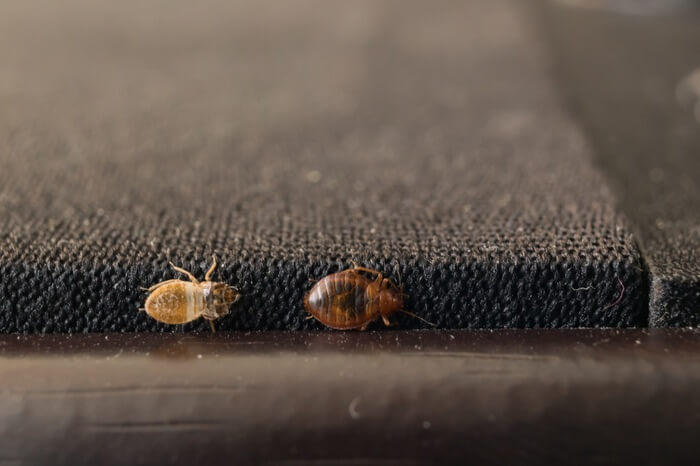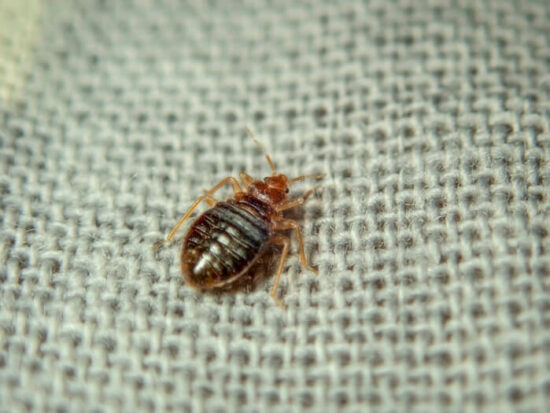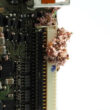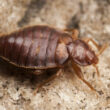Finding bed bugs in electronics can be rather unnerving. We know that these little insects can potentially show up in a bedroom, but infesting our precious devices is going too far!
In this guide we’ll go over how to get bed bugs out of electronics, and the various treatment methods you can use. It’s not as hard as you might think!
Table of contents
Can Bed Bugs Live In Electronics?
Bed bugs are one of the most feared pests around. Not only do they bite you in the dead of night, but they can spread very fast. The reason for their quick proliferation is that bed bugs can easily slip into tight spots that help them evade harm and capture.
We all know that you can find these pets inside mattresses and bedroom furniture. But what about finding bed bugs in electronics?
Unfortunately for us, bed bugs are capable of living in electronics. The insects can fit into the tiniest of cracks and holes. A spot that’s big enough to slip a credit card into has more than enough room for a bed bug to enter.

Now, that doesn’t mean that you’ll find bed bugs living in all the electronics throughout your home! If anything, you’ll only spot them inside the gadgets you keep in your room.
- Kills common household ants including acrobat, crazy, ghost, little black, odorous house, pavement, and other sweet-eating ants
- As worker ants discover the bait, they share it with the rest of the colony to eliminate them all
- You should see a significant decrease in the number of ants visiting the bait stations within just a few days
- Place stations near areas where you’ve seen ant activity
Ultimately, a bed bug’s goal is to stay as close to its food source as possible. So, they may gravitate towards the items that you keep around your bed. That could be a laptop you keep plugged in on the floor, your alarm clock on the bedside table, or a remote for your TV. Anything is fair game.
Quick Tip: Electronics can be good temporary hiding spots for bed bugs. It’s just discrete enough to keep them safe. Plus, the residual warmth of the device is suitable for short-term comfort.
The Likelihood Of Bed Bugs Being In Electronics
While it’s possible to find bed bugs in electronics, the likelihood of that happening is low. That’s the good news!
Here’s why:
Electronics aren’t suitable for long-term living. There’s a good chance that you use those devices regularly, and the constant jostling around will make it unappealing for bed bugs.
Not only that, but the residual heat can become overbearing pretty quickly. Bed bugs only need warmth when they’re feeding. During those times of rest and digestion, they’ll want to move elsewhere.
Another significant issue is space.
Quick Tip: In the past, electronics were large and clunky. While advanced at the time, old-school gadgets are pretty archaic by today’s standards. They had a lot of empty space for cool air to travel. As a result, they could easily become a breeding ground for bed bugs!
Today, electronics are thin. Cooling methods are much more streamlined, leaving little room for waste.
Bed bugs can still hide in your electronics, but it’s rare. Their presence is usually temporary at best.
How To Get Bed Bugs Out Of Electronics
If you’re unlucky enough to discover these bloodsuckers in your electronics, don’t fret. Learning how to get bed bugs out of electronics won’t take too much time.
With that being said, dealing with electronic devices is a little trickier than handling infested furniture. The intricate nature of these gadgets requires a careful hand and some vigilance. You may have to try multiple techniques to get rid of them all.
Here are some of the most effective ways to treat electronics for bed bugs.
1. Freeze
Here’s a quick and easy way to deal with bed bugs in electronics.
These pests cannot survive in freezing temperatures. They’re pretty resilient in a wide range of environments, but they do have their limits.
Place the device they’re hiding in inside a resealable plastic bag. Then, pop it into your freezer.
Leave it in the ice chest for about four days. That should be long enough to kill all of the bugs.
Once done, remove your device and dispose of the bag properly.
2. Heat
On the opposite end of the temperature spectrum, you can use heat!
Bed bugs die when exposed to temperatures around 120 degrees Fahrenheit. It’s not an instant kill. Usually, 30 minutes of exposure at 120 degrees will do the trick. It might take even less time at higher heat settings.
Quick Tip: Bed bugs can adjust their body temperature, but 120 degrees is the point of no return for these insects!
So, how do you apply heat?
First, you have to prepare your device and make sure that it’ll handle the heat without any issues. All electronics have a standard operating temperature. When you exceed that limit, you can cause irreparable damage to the device itself.
Not only that, but you could create a safety risk. Batteries, for example, can explode when the temperature is too high.
Check all of that crucial information with the manufacturer. Then, remove any batteries and other sensitive components. For example, ink cartridges, paper receptacles, and more could suffer damage.
To reach the temperatures you need, the most effective way is to seek help from a professional exterminator. Exterminators have access to a couple of different handy tools to get the job done.
The first is a heater that will raise the temperature in the entire room. This is a good choice if the gadget in question is big. You can also use this method if you’re worried about a larger population that could be hiding in your room.
As the heater works its magic, all bed bugs in the nearby electronics will die. However, you have to prepare the entire space to ensure that it’s safe.
Alternatively, you can use an enclosed space heater. These pop-up devices look like little saunas. The heater raises the temperature in the enclosed box, which is big enough for most electronics.
3. Vacuum
Your vacuum is your best friend when getting bed bugs out of electronics!
These insects are no match for the strong suction power of a high-quality vacuum cleaner. The machine doesn’t necessarily kill the bugs, but it can contain them for easy disposal later.
We recommend using a vacuum that’s geared towards allergy sufferers. They usually have tighter seals around the bag and a HEPA filter. Those extra layers of protection will ensure that the pests don’t escape after getting sucked up.
When using a vacuum to treat electronics for bed bugs, you’ll need small attachments to get into as many nooks and crannies as possible. It also pays to have some essential tools on hand.
Quick Tip: You may need to disassemble the gadget partially to gain access to the bed bugs. Just make sure that you stay organized and know how to put everything back together afterward.
4. Tape & Drown
The tape and drown method is simple, but it’s surprisingly effective for smaller devices.
All you’ll need is a playing card, some strong tape, and a glass of alcohol.
The goal here is to physically remove the bugs by using the card. Remember, bed bugs can fit anywhere that a credit card can slide. This removal method uses that knowledge to your advantage.
Use the card to push the bugs out. Then, quickly use the tape to keep them in place. Once you have a decent amount on the piece of tape, toss it in the glass of alcohol to kill them. Bed bugs can survive for a while in water, so alcohol is a better choice.
5. Neem Oil
Neem oil is a fantastic tool to have in your bug-killing arsenal. Bed bugs hate neem oil and it has a scent that keeps them away. Not only is the smell unpleasant, but it also affects many biological processes.
On contact, the oil can coat the breathing holes of the bug to suffocate them slowly. If that doesn’t work, the chemical compounds within the substance can change feeding patterns, reproductive behaviors, egg maturation, and more.
When using neem oil to get bed bugs out of electronics, you’ll need a rag and a thick, sealable plastic bag. Spray the rag with about three tablespoons of neem oil. Then, put the device and the rag into the plastic bag.
Quick Tip: Wait about a week for the oil to do its job. Neem oil has a very high mortality rate, but it takes some time to work. Be patient to ensure that you’re killing as many pests as possible.
6. Nuvan ProStrips
Using Nuvan ProStrips is one of the most efficient ways to treat electronics for bed bugs. The strips emit DDVP vapor. DDVP, also known as dichlorovinyl dimethyl phosphate, is a strong chemical insecticide.
Not only does it kill bed bugs, but the vapor can penetrate just about anything. Even if the bugs are hiding in difficult-to-reach spots within your electronics, the vapor will make its way to them!
To use the Nuvan ProStrips, you’ll need a thick contractor bag for containment. We recommend using a bag that’s at least 2 mm thick to ensure that none of the vapor comes out.
Quick Tip: The chemicals pose health and safety risks, so make sure to read all the instructions carefully before you start. It’s a good idea to wear some skin, eye, and throat protection, too.
Initiating the vapor is easy. Remove the strips from the package, place them in the included holder, and set the entire thing in the bag. Put your electronics in there and seal everything up.
Let the vapor work for at least 48 hours. Some professionals recommend waiting for as long as 10 days for the best results.
After the waiting time is over, open the bag and let it air out for several hours. Even still, make sure to wear protection when reaching into the bag.
Signs That You Have A Problem
Thanks to their nocturnal nature, small size, and penchant for hiding, bed bugs often go unnoticed. They’re even more discreet when living in electronics.
All that said, there are many telltale signs that you’re dealing with bed bugs inside electronics.
The most obvious is seeing the bugs crawling out of your electronic devices! This is most likely to occur at night when the pests are most active. They are oval-shaped, flat, and about the side of an apple seed.
You can also look to your skin for signs of the bugs’ presence. Bed bug bites look like a series of red dots. They itch and can appear on the legs, arms, belly, and any other part of the body.
It’s possible to see messes these bugs leave behind as well. Small splotches of dry blood are hard to miss. They can appear on your bed sheets or on the electronic device itself.
The same goes for feces. Bed bug droppings look like rust-colored smears. Because the bugs poop wherever they go, you might see those signature stains around the openings of your device.
Quick Tip: If you can gain access to the inside of your gadget, there’s a good chance you’ll see the messy den. It’s brown and rusty-looking, which indicates that the bugs spent some time there!
How To Stop Them From Getting Into Your Electronics
Even after you get the existing bed bugs out of your electronics, there’s always a chance that they’ll come back. Bed bugs are resilient and determined! As long as there are people to feed on, these pests will find a way!
The best way to prevent future infestations is to clean regularly. That’s not to see that bed bugs only invade filthy homes. Nothing could be farther from the truth.
However, cleaning will eliminate bugs as they come, which could stop larger populations from flourishing.
Adopt a regular vacuuming schedule. Use it to clean every inch of your room. Stick to a routine, and the bugs will get sucked up before they can ever get to your electronics!
On top of that, you can treat your home with insecticides and repellents. Chemical-based products are readily available at most home stores. You can find both instant-kill products and long-lasting ones.
We recommend using the latter for continued protection.
If you want to avoid chemical products, natural alternatives exist, too. Sprays that utilize vinegar and essential oils are surprisingly effective. The same goes for neem oil, which we discussed earlier. Use it to make a spray solution that keeps bed bugs out!
Regularly cleaning and treating your home is a surefire way to stop bugs from entering.
Quick Tip: It’s also good to take some safety precautions when traveling. Always treat your luggage when you return to ensure that you’re not bringing any hitchhiking bed bugs into your domain!
Can They Do Damage?
Many pests can do significant damage to your electronics. Fortunately, bed bugs aren’t one of them.
These insects are far too small to make any real impact. They’ll make the gadget filthy! But as far as actual damage goes, the odds of them harming your electronic devices are slim to none.
Theoretically, the waste and droppings they leave behind could cause some trouble with more intricate electronics. However, standard consumer-grade devices should be just fine.
Interestingly enough, treating electronics for bed bugs can sometimes do more damage than the pests themselves!
One of the biggest mistakes homeowners make when they discover these pests is to resort to insecticide sprays immediately. Chemical-based products are fine when you’re talking about furniture, carpet, or general home infestations.
But delicate electronics?
Liquids and delicate electrical components don’t mix! Resorting to spray right off the bat is a quick way to damage your products beyond repair.
Instead of doing that, try some of the treatment methods we went over earlier! They are generally safe and can get rid of the bugs without causing too much harm.
Of course, it’s always important to take safety precautions anytime you’re dealing with electricity or anything that could shock you.
Can They Live In A TV?
Bed bugs can live in TVs, but the chances of that happening are pretty low these days.
While more and more people are starting to install televisions in the bedroom, the types of TVs they’re using aren’t suitable for bed bugs!
Today’s market is chock-full of paper-thin TVs. Thin is in, and that trend shows no signs of slowing down!
In the past, clunky tube TVs were perfect for bed bugs because they had tons of room to hide. That’s not the case with modern television sets.
Some of the newer models don’t even have room for processing components and power supplies. They have to connect to an external module, which leaves even less room for bugs!
While bed bugs can live in chunkier TVs, having these insects invade your most prized electronic device is less of a problem than it used to be.
Can They Live In A Laptop Computer?
It all depends on the build of the laptop.
A mere decade ago, laptops were a lot thicker. They had chunky fans and cooling systems, which gave bed bugs plenty of wiggle room to get in. On older models, these insects could even get into the main chassis where the chips were!
Today, it’s a lot harder for bed bugs to get into a laptop computer. Like TVs, laptops are slimmer than ever! Modern unibody laptops barely have any ports to begin with, which only reduces the access points for bugs even more.
As if the lack of space weren’t enough to turn bed bugs away, the level of heat laptops produce will drive them out. Many laptops can get pretty hot inside! With regular use, those temperature spikes are far too much for a bed bug to handle.
Unless you have a beefier laptop with tons of ports and air holes, there shouldn’t be too much of a risk for bed bug infestations.
Final Thoughts
There are various ways to get bed bugs out of electronics. While these insects are persistent and challenging to deal with, at least one of these treatment methods should work for you!
If you have a particularly difficult case on your hands, let us know. We’re more than happy to give you some extra tips!



